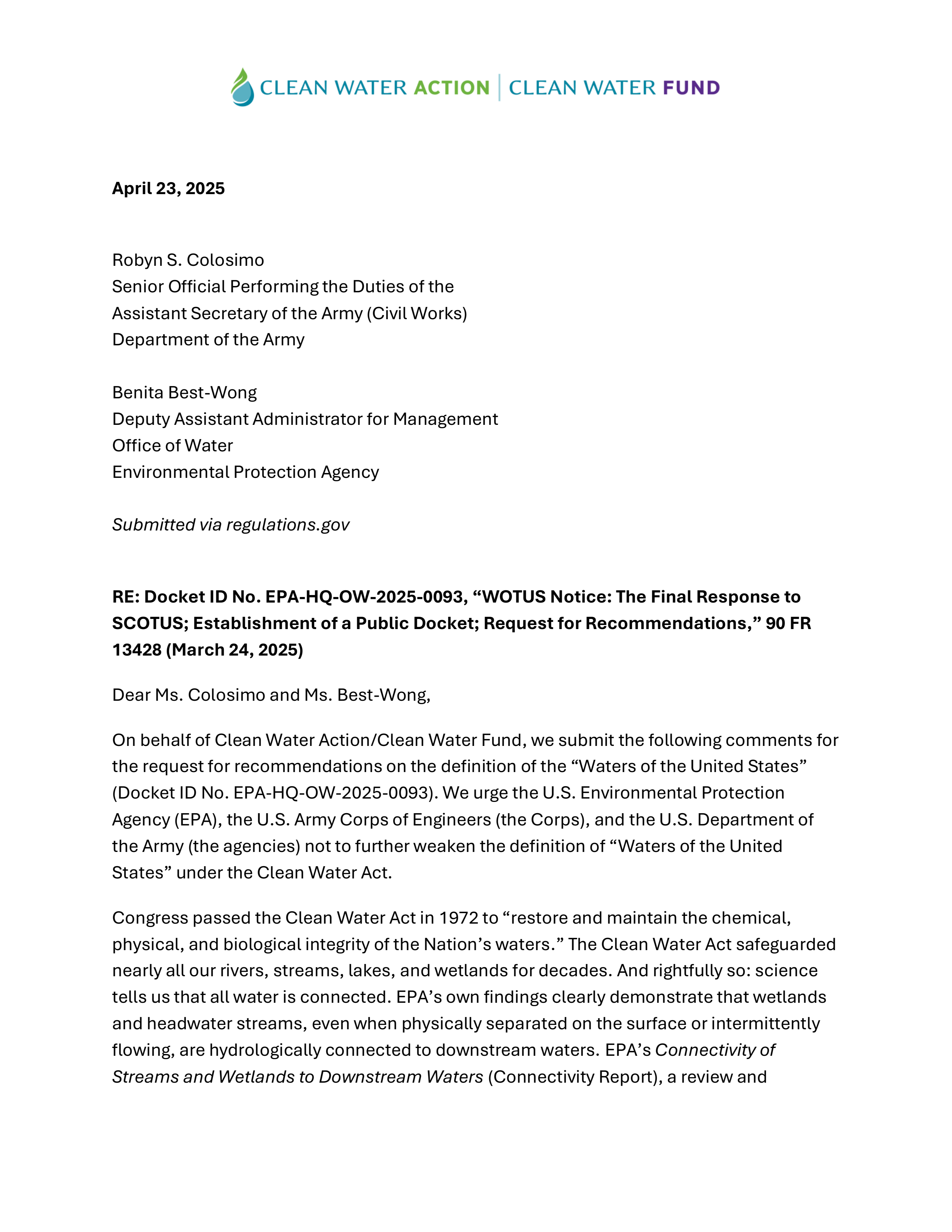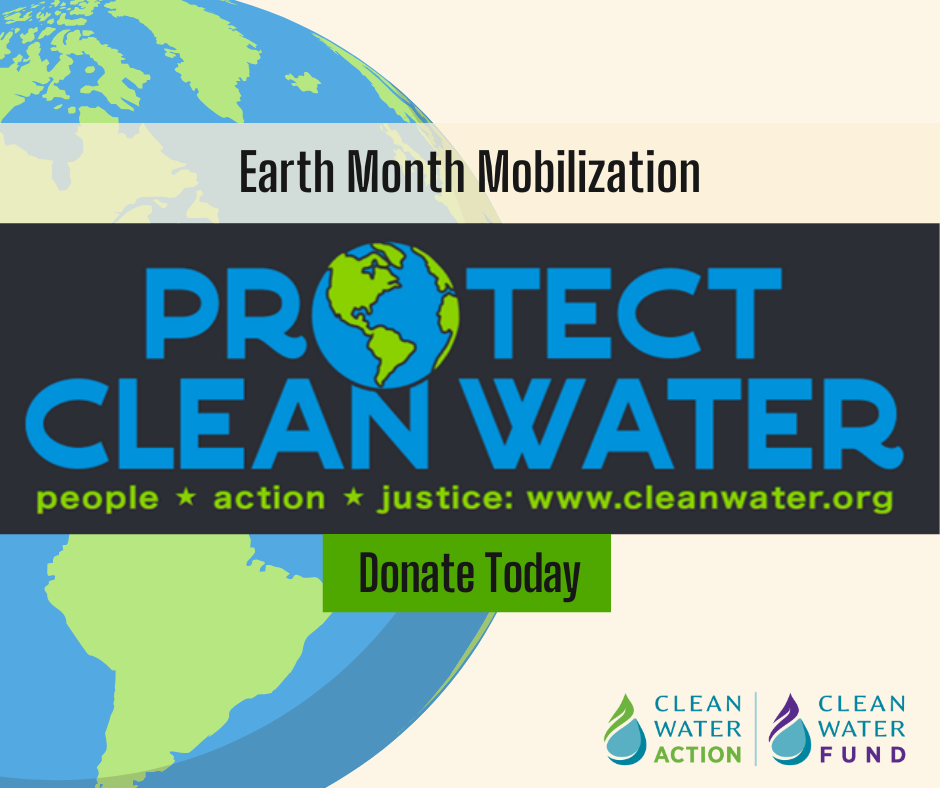RE: Docket ID No. EPA-HQ-OW-2025-0093, “WOTUS Notice: The Final Response to
SCOTUS; Establishment of a Public Docket; Request for Recommendations,” 90 FR
13428 (March 24, 2025)
Addressed to Robyn S. Colosimo, Senior Official Performing the Duties of the Assistant Secretary of the Army (Civil Works), Department of the Army, and Benita Best-Wong, Deputy Assistant Administrator for Management, Office of Water, Environmental Protection Agency
Submitted via regulations.gov
Dear Ms. Colosimo and Ms. Best-Wong,
On behalf of Clean Water Action/Clean Water Fund, we submit the following comments for the request for recommendations on the definition of the “Waters of the United States” (Docket ID No. EPA-HQ-OW-2025-0093). We urge the U.S. Environmental Protection Agency (EPA), the U.S. Army Corps of Engineers (the Corps), and the U.S. Department of
the Army (the agencies) not to further weaken the definition of “Waters of the United States” under the Clean Water Act.
Congress passed the Clean Water Act in 1972 to “restore and maintain the chemical, physical, and biological integrity of the Nation’s waters.” The Clean Water Act safeguarded nearly all our rivers, streams, lakes, and wetlands for decades. And rightfully so: science tells us that all water is connected. EPA’s own findings clearly demonstrate that wetlands and headwater streams, even when physically separated on the surface or intermittently flowing, are hydrologically connected to downstream waters. EPA’s Connectivity of Streams and Wetlands to Downstream Waters (Connectivity Report), a review and synthesis of numerous peer-reviewed scientific publications, highlighted the important role that these water bodies play in supporting the health of downstream waters.1
These findings were further bolstered in December 2022 when EPA and the Corps analyzed the conclusions of thousands of peer-reviewed papers published since the Connectivity Report, stating: “...the evidence reviewed is conclusive: ephemerally, intermittently, and perennially flowing streams, floodplain wetlands and open waters, and non-floodplain wetland and open waters are hydrologically, biologically, chemically, and functionally connected to downstream systems and substantively and definitively affect down-gradient aquatic systems.”2
Streams that only flow seasonally or after a rainfall perform the same vital functions as streams that flow year-round. Wetlands that may not appear connected on the surface still provide critical ecosystem services. These water resources play essential roles in protecting drinking water sources, filtering harmful pollution, capturing nutrients, reducing impacts from flooding, regulating the climate through carbon sequestration, providing essential habitat for fish and other wildlife, and lowering costs for water systems and their customers. Clean Water Action/Clean Water Fund released a white paper, which is attached to these comments, explaining the importance of protecting all water resources in order to protect our drinking water sources.
The U.S. Supreme Court Sackett v. EPA decision significantly weakened federal water protections under the Clean Water Act. We are deeply concerned that the current efforts to further narrow Clean Water Act protections go beyond what is required by the Sackett v. EPA decision. The Biden Administration complied with the ruling and released a final conforming rule that aligns with the Sackett v. EPA decision; therefore, no further changes that further weaken protections related to “relatively permanent” and “continuous surface connection” are necessary. Clean Water Action/Clean Water Fund strongly urges the Agencies to refrain from making any additional changes to weaken the definition of the “Waters of the United States.”
Even though the Sackett v. EPA decision was one of the largest setbacks for Clean Water Act protections, special interests are still not satisfied. The current comment period invites lobbying groups and polluting stakeholders to weigh in on highly technical Clean Water Act definitions—areas which should be guided by science, not by those seeking to avoid Clean Water Act requirements. The only people pushing for EPA to weaken protections for water bodies are the industries who will profit if it is easier to pave over or plow under a stream or wetlands.
The EPA’s role as a steward of our nation’s waters must remain grounded in science, protect water resources for all uses, and uphold the Clean Water Act’s original intent to protect all water—not just those that flow year-round or are visibly connected by surface flow. Further narrowing the Clean Water Act protections—especially based on how industry and polluting interests interpret “relatively permanent” and “continuous surface connection”— would not only contradict the original goal of the Clean Water Act, but it would also disregard decades of peer-reviewed research and the Agencies’ own scientific
assessments. This would result in the removal of essential protections for wetlands and streams that are scientifically understood to support downstream water quality, mitigate flooding, and promote ecological health. The weakening of federal jurisdiction over these waters poses serious risks to public health, drinking water sources, and climate resilience, particularly in communities already overburdened by environmental and infrastructure challenges. EPA should uphold its mission to enforce our landmark environmental protection laws that protect human health and the environment and should be
strengthening, not weakening, Clean Water Act protections.
In summary, Clean Water Action/Clean Water Fund strongly urges the agencies refrain from taking any further steps that would narrow the definition of the “Waters of the United States.”
Sincerely,
Julie MacNamara
National Water Projects Coordinator
Clean Water Action / Clean Water Fund
jmacnamara@cleanwater.org
ATTACHMENT: Putting Drinking Water First fact sheet
1 Environmental Protection Agency, Office of Research and Development, Connectivity of Streams & Wetlands to Downstream Waters: A Review & Synthesis of the Scientific Evidence, EPA/600/R-14-475F, January 2015, http://cfpub.epa.gov/ncea/cfm/recordisplay.cfm?deid=296414.
2 Department of the Army, Corps of Engineers, and Environmental Protection Agency, Technical Support Document for the Final “Revised Definition of ‘Waters of the United States’” Rule, December 2022, https://www.epa.gov/system/files/documents/2022-12/TSD-FinalCombined_508.pdf.

